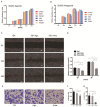DRG Neurons Promote Perineural Invasion of Endometrial Cancer via GluR2
- PMID: 32201522
- PMCID: PMC7066017
- DOI: 10.7150/jca.40055
DRG Neurons Promote Perineural Invasion of Endometrial Cancer via GluR2
Abstract
Background: Perineural invasion (PNI) is correlated with negative prognosis in multiple cancers, but its role in endometrial cancer (EC) is still largely unknown; thus, targeted treatment for nerve infiltration is lacking as well. Methods: The interaction between nerve and EC cells were investigated by in vitro neural invasion assay and transwell coculture system. Then the nerve-related receptor gene glutamate ionotropic receptor AMPA type subunit 2 (GRIA2) was detected in EC tissues and cells using PCR array, western blotting, and immunohistochemistry. The role of GluR2 (gene name GRIA2) on EC proliferation, migration and invasion was evaluated by a GluR2 antagonist and shRNA. At the same time, the neurotransmitter effect on GluR2 (glutamate) from the cocultured conditional medium was measured using high-performance liquid chromatography (HPLC). Results: EC cell line Ishikawa (ISK) showed the ability to migrate along neurites in vitro and the numbers of migrated/invaded EC cells in the DRG neuron coculture group were significantly increased. The expression of GluR2 in EC tissue was found to be higher than that in para-carcinoma tissue. After GluR2 antagonist and GluR2 shRNA treatment, the proliferation, migration and invasion of ISK cells was markedly inhibited. Moreover, the ability of DRG neurons to promote the migration and invasion of ISK cells could also be attenuated by downregulation of GluR2, and the concentration of the neurotransmitter glutamate was notably increased in the coculture conditional medium compared to that in the DRG neuron or ISK cells alone. Conclusions: DRG neurons promote metastasis of EC cells via GluR2, which might be a risk factor for PNI in EC. Moreover, the perineural system may promote tumor invasion and metastasis under certain circumstances.
Keywords: DRG neurons; GluR2; endometrial cancer; metastasis; perineural invasion.
© The author(s).
Conflict of interest statement
Competing Interests: The authors have declared that no competing interest exists.
Figures






Similar articles
-
Enhanced survival in perineural invasion of pancreatic cancer: an in vitro approach.Hum Pathol. 2007 Feb;38(2):299-307. doi: 10.1016/j.humpath.2006.08.002. Epub 2006 Nov 13. Hum Pathol. 2007. PMID: 17097719
-
In vitro dorsal root ganglia and human prostate cell line interaction: redefining perineural invasion in prostate cancer.Prostate. 2001 Nov 1;49(3):213-23. doi: 10.1002/pros.1137. Prostate. 2001. PMID: 11746267
-
The role of the SDF-1/ CXCR7 axis on the growth and invasion ability of endometrial cancer cells.Arch Gynecol Obstet. 2017 Apr;295(4):987-995. doi: 10.1007/s00404-017-4308-x. Epub 2017 Feb 27. Arch Gynecol Obstet. 2017. PMID: 28239742
-
The AMPAR subunit GluR2: still front and center-stage.Brain Res. 2000 Dec 15;886(1-2):190-207. doi: 10.1016/s0006-8993(00)02951-6. Brain Res. 2000. PMID: 11119696 Review.
-
Neuroscience of cancer: Research progress and emerging of the field.Ibrain. 2024 Aug 14;10(3):305-322. doi: 10.1002/ibra.12172. eCollection 2024 Fall. Ibrain. 2024. PMID: 39346791 Free PMC article. Review.
Cited by
-
Cerebral Microvascular Injury Induced by Lag3-Dependent α-Synuclein Fibril Endocytosis Exacerbates Cognitive Impairment in a Mouse Model of α-Synucleinopathies.Adv Sci (Weinh). 2023 Sep;10(25):e2301903. doi: 10.1002/advs.202301903. Epub 2023 Jun 28. Adv Sci (Weinh). 2023. PMID: 37381656 Free PMC article.
-
Perineural Invasion in Cervical Cancer: A Hidden Trail for Metastasis.Diagnostics (Basel). 2024 Jul 14;14(14):1517. doi: 10.3390/diagnostics14141517. Diagnostics (Basel). 2024. PMID: 39061654 Free PMC article. Review.
-
Overexpression of TICRR and PPIF confer poor prognosis in endometrial cancer identified by gene co-expression network analysis.Aging (Albany NY). 2021 Jan 20;13(3):4564-4589. doi: 10.18632/aging.202417. Epub 2021 Jan 20. Aging (Albany NY). 2021. PMID: 33495413 Free PMC article.
-
GRIA2/ENPP3 Regulates the Proliferation and Migration of Vascular Smooth Muscle Cells in the Restenosis Process Post-PTA in Lower Extremity Arteries.Front Physiol. 2021 Aug 24;12:712400. doi: 10.3389/fphys.2021.712400. eCollection 2021. Front Physiol. 2021. PMID: 34504438 Free PMC article.
-
Exploring the Role of Metabolites in Cancer and the Associated Nerve Crosstalk.Nutrients. 2022 Apr 21;14(9):1722. doi: 10.3390/nu14091722. Nutrients. 2022. PMID: 35565690 Free PMC article. Review.
References
-
- Siegel RL, Miller KD, Jemal A. Cancer Statistics, 2017. CA cancer. J. Clin. 2017;67:7–30. - PubMed
-
- Morice P, Leary A, Creutzberg C. et al. Endometrial cancer. Lancet. 2016;387:1094–1108. - PubMed
-
- Fleming GF, Brunetto VL, Cella D. et al. Phase III trial of doxorubicin plus cisplatin with or without paclitaxel plus filgrastim in advanced endometrial carcinoma: a Gynecologic Oncology Group Study. J Clin Oncol. 2004;22:2159–2166. - PubMed
-
- Sutton G, Axelrod JH, Bundy BN. et al. Whole abdominal radiotherapy in the adjuvant treatment of patients with stage III and IV endometrial cancer: a gynecologic oncology group study. Gynecol Oncol. 2005;97:755–763. - PubMed
-
- Jobling P, Pundavela J, Oliveira SM. et al. Nerve-Cancer Cell Cross-talk: A Novel Promoter of Tumor Progression. Cancer Res. 2015;75:1777–1781. - PubMed
LinkOut - more resources
Full Text Sources

